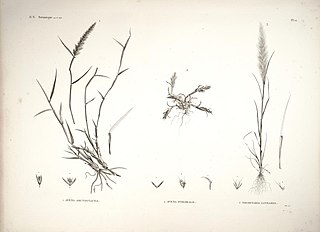
Nepeta is a genus of flowering plants in the family Lamiaceae. The genus name, from Latin nepeta (“catnip”), is reportedly in reference to Nepete, an ancient Etruscan city. There are about 250 species.

Alopecurus, or foxtail grass, is a common and widespread genus of plants in the grass family. It is common across temperate and subtropical parts of Eurasia, northern Africa, and the Americas, as well as naturalized in Australia and on various islands.

Polygonum is a genus of about 130 species of flowering plants in the buckwheat and knotweed family Polygonaceae. Common names include knotweed and knotgrass. In the Middle English glossary of herbs Alphita, it was known as ars-smerte. There have been various opinions about how broadly the genus should be defined. For example, buckwheat has sometimes been included in the genus as Polygonum fagopyrum. Former genera such as Polygonella have been subsumed into Polygonum; other genera have been split off.

Anthemis is a genus of aromatic flowering plants in the family Asteraceae, closely related to Chamaemelum, and like that genus, known by the common name chamomile; some species are also called dog-fennel or mayweed. Anthemis are native to the Mediterranean region and southwest Asia east to Iran. A number of species have also become naturalized in the United Kingdom and other parts of the world.

Sonchus is a genus of flowering plants in the tribe Cichorieae within the family Asteraceae and are commonly known as sow thistles. Sowthistles are annual, biennial or perennial herbs, with or without rhizomes and a few are even woody.

The Lebanon viper, also known as Bornmueller's viper, is a species of venomous snake in the subfamily Viperinae of the family Viperidae. The species is native to Western Asia. There are no recognized subspecies.

Franz Josef Maria Werner was an Austrian zoologist and explorer. Specializing as a herpetologist and entomologist, Werner described numerous species and other taxa of frogs, snakes, insects, and other organisms.

Launaea is a genus of flowering plants in the family Asteraceae.
Crotaphatrema bornmuelleri is a species of caecilian in the family Scolecomorphidae. It is endemic to Cameroon. The specific name bornmuelleri honours Joseph Friedrich Nicolaus Bornmüller, a German botanist. Common names Bornmuller's caecilian and Bornmüller's caecilian have been coined for it.

Joseph Friedrich Nicolaus Bornmüller was a German botanist born in Hildburghausen, Thuringia.

Hermon nature reserve is a nature reserve in the north of the Golan Heights. It includes an area in southern Mount Hermon which is located in the Israeli occupied portion of the Golan Heights. The reserve excludes the Mount Hermon ski resort, Neve Ativ and the Nimrod Fortress National Park. The total area of the reserve is approximately 78,270 dunam.

Colchicum speciosum is a species of flowering plant in the family Colchicaceae, native to mountainous areas of northern Turkey, the Caucasus and northern Iran. Growing to 18 cm (7 in) tall by 10 cm (4 in) wide, it is an herbaceous perennial growing from corms. C. speciosum blooms in the fall, producing reddish/violet flowers on stems up to 30 centimetres (12 in) tall without any leaves present. The strap-like leaves grow in the spring, then yellow, wither and die back as summer progresses. The flowers strongly resemble those of the crocus, the familiar spring-flowering bulb; hence the common name autumn crocus which is applied to this and other colchicum species. However the two genera belong to different families; and there is in fact an autumn-flowering crocus species, Crocus sativus, the source of the spice saffron. By contrast, all parts of Colchicum speciosum are toxic if ingested.

Sonchus bornmuelleri, or Bornmueller's sow-thistle, is a plant endemic to the Canary Island of La Palma.
Rojasia is a group of plants in the family Apocynaceae first described as a genus in 1905. As of December 2022, Plants of the World Online accepted two species:

Klasea is a genus of Eurasian and North African plants in the tribe Cardueae within the family Asteraceae.

Erucaria is a genus of flowering plants of the family Brassicaceae, commonly known as Pink-mustard. It contains the following species:

Trisetaria is a genus of plants in the grass family, native to Asia and to the Mediterranean region.
Asterolecanium is a genus of pit scale insects. Asterolecanium is distributed worldwide: species have been found in each of the six biogeographic realms, and nearly all of their respective subregions.
Antiphytum, commonly known as saucerflower, is a genus of flowering plants belonging to the family Boraginaceae.















